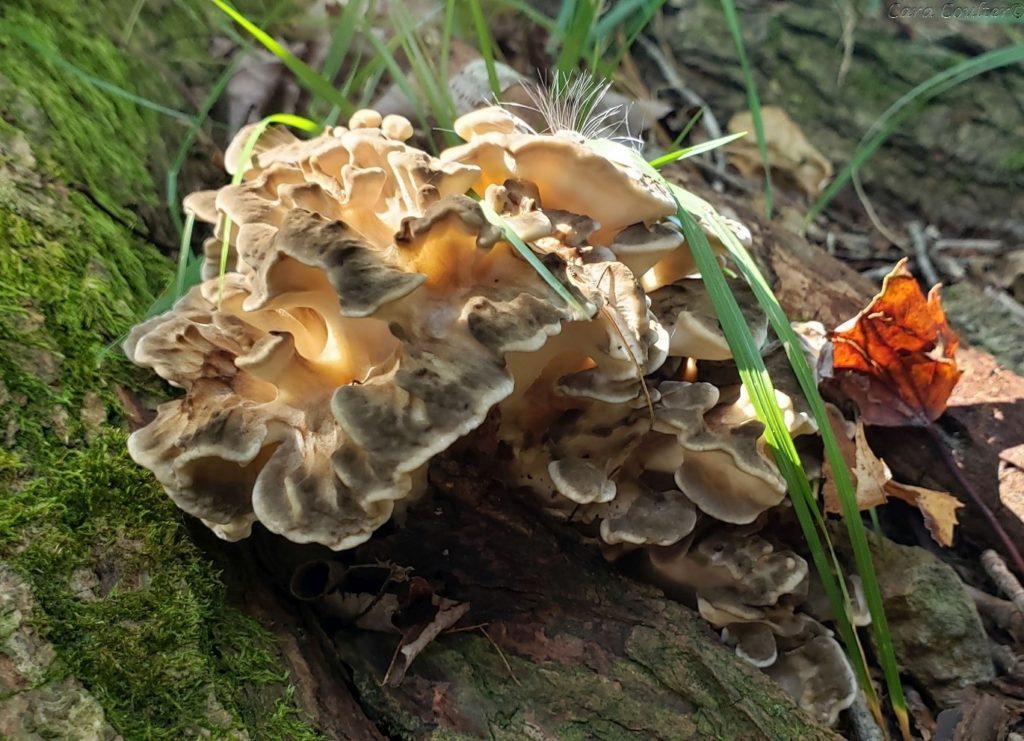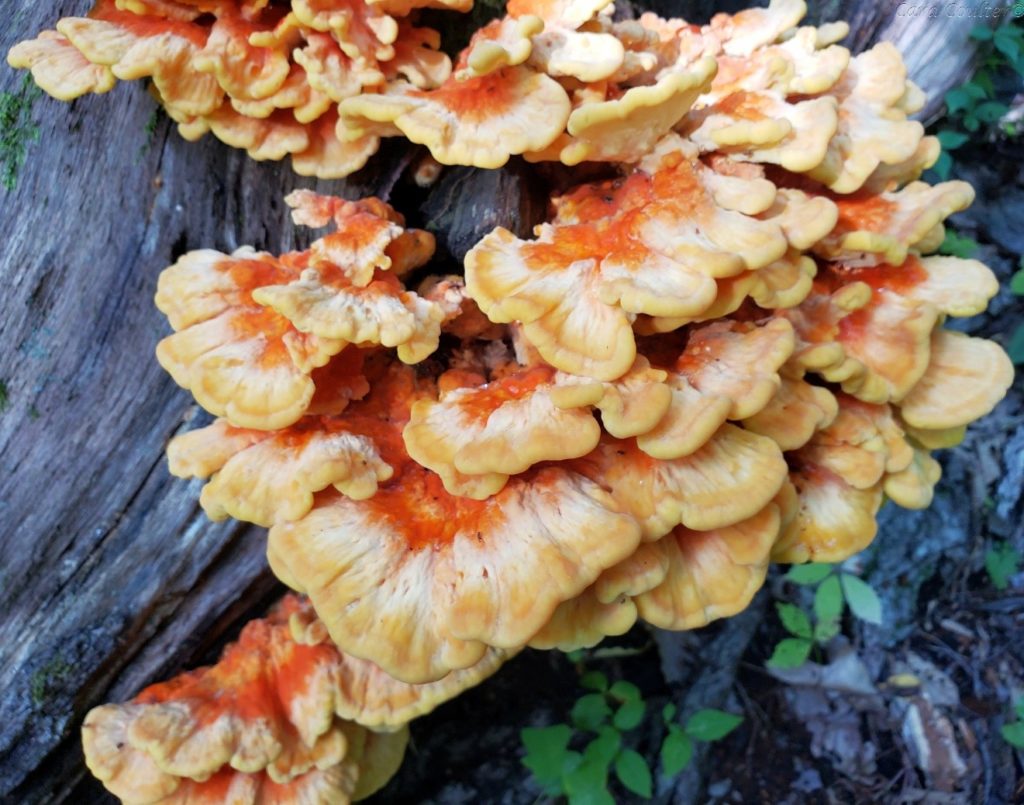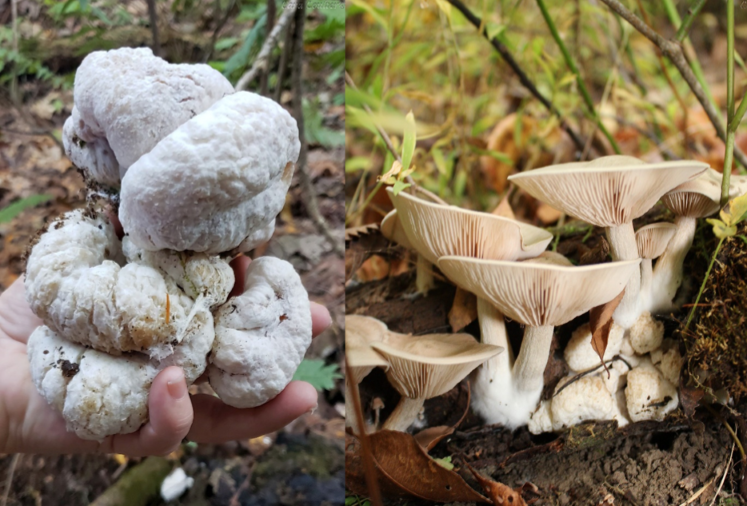(Above photo: Tristan Coulter holding some Chicken of the Woods he found.)
Written by Cara Barkley Coulter, Vice President of the Western PA Mushroom Club
Autumn is a thrilling time for our Western Pennsylvania Mushroom Club members. With some of our favorite wild edible mushrooms beginning to grow, we start to go into a frenzy! When the temperatures start to drop, there comes a flush of the most delicious fall fungi. Foragers race to the largest oak trees and carefully check the bases of as many as they can find, hoping to fill their wicker basket with a delicious treat, like Hen of the Woods (Grifola frondosa).
A peace comes over a forager while trekking along. While scanning the forest floor, your mind isn’t thinking about the stressors of the day. It’s kept too busy honing your senses, soaking in the habitat surrounding them, checking the trees, the soil, the logs, et cetera. Then there is the feeling of excitement when you finally find the treasure you were looking for. It’s a joy that the entire family can partake in.
I highly recommend bringing your children along for the journey. They’ll delight in helping you find your prize. Best of all, they’re really good at it! There are plenty of kid friendly books , online tutorial videos, and even flash cards to help your child recognize some of the safe and more common edible fungi you may come across. Still there is nothing better than joining one of our WPA Mushroom Club walks to learn. Every walk has a board approved identifier, ready to help answer your questions and show you first hand the important identifying features.
So it’s fall. You want to get out there and start looking! What kind of tasty fungi are you going to find this time of year?
1.) Hen of the Woods (Grifola frondosa)

One of the most highly sought after fall edibles is the Hen of the Woods (Grifola frondosa). It has tiny holes underneath called pores instead of gills, and it hides at the bases of large oak trees. Most people will pass these by without notice, even in the busiest of areas, thinking it’s merely a pile of leaves. If you are lucky enough to find one, you’ll find its delicate, gray tongue-like fronds make a marvelous addition to soups and sandwiches and are also a fantastic vegan meat alternative. It’s one of the safer species to forage because its only lookalikes are also edible (though a lot tougher and less versatile).
2.) Chicken of the Woods (Laetiporus sulphureus)

This fungus is one you can find all summer long, and not just in the fall! With its beautiful and vibrant shades of yellows and oranges, it’s difficult to mistake this fungus for anything else. Chicken of the Woods has tiny pores instead of gills underneath its colorful shelves. It’s usually found on decaying logs or dying trees.
3.) Shrimp of the Woods (Entoloma abortivum)

Here we show both the aborted (left) and non-aborted (right) forms
This white, gnarly mushroom may not be the prettiest find, but it certainly tastes delectable! Found on the ground, often near stumps or at the base of deciduous trees, this sweet-smelling mushroom makes a great shrimp substitute. This edible abomination is created when the Entoloma starts to take over a honey mushroom. When this transformation happens, we often get the large white twisted gill-less ball form that you see on the left. This is called its aborted form. Sometimes, during the transformation, it becomes the beautiful snowy white gilled version you see on the right, called its non-aborted form. It’s hard to mistake the aborted form for any other mushroom, but I recommend avoiding the non-aborted form, which has a few toxic lookalikes.
Remember…
Before consuming any mushroom, be sure that you are 100% on your ID. Always cook wild mushrooms. When consuming a new mushroom, start small and slow. Have a few tiny bites and then wait a few hours and check to make sure you don’t have a reaction (As with any food people can have reactions even to edible mushrooms). Eat a bit more the next day and repeat the process. We are not responsible for the reaction of any fungi you ingest or misidentify.
Follow state regulations. Foraging in PA state parks and forests is acceptable for personal use but not for sale or in great quantity. “Gathering edible fruits, nuts, berries and fungi, in reasonable amounts, for one’s own personal or family consumption. This permission does not apply to wild plants listed in Chapter 45 (relating to conservation of Pennsylvania native wild plants) as threatened, endangered, rare or vulnerable.”




